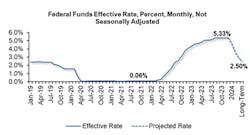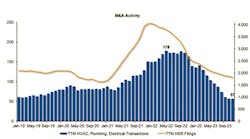Beachballs and HVAC: 2024 Outlook for HPE Markets
Report compiled by Anchor Peabody
Strong growth was unsustainable
Source: AHRI
2023 brought about a sea change in the industry from what we experienced coming out of COVID in 2021 and 2022. Equipment unit volume started the year off trending lower year-over-year and continued to consistently trend lower through the balance of the year. Taking a step back to take this into account from a historical perspective, the decline in volume growth last year should be viewed as a “cooling off” from the torrid pace of 15% to 20% year-over-year growth of the prior two years which was simply unsustainable to expect that growth to continue in perpetuity. One could characterize the past year as a process of normalizing volume growth rate to more sustainable, historical patterns which is typically closely correlated with nominal GDP growth.
The expectation as we head into 2024 is for this normalization process to eventually trough or bottom out and there will be a resumption of growth to close out the year with a bullish backdrop heading into next year. This is encouraging news for the family-owned, local independents/entrepreneurs who are gearing up for a potential sale process this year.
The distortions to the market stemming from the amount of monetary and fiscal stimulus injected into the economy in response to the COVID recession were still being felt in 2023. The entire industry enjoyed the incredible spike in demand in 2021 and 2022 due in large part to stimulus in the system and the health of consumer and corporate balance sheets. Now we’re on the other side of the peak surge in demand from the summer of 2021 and have gone through a period of “indigestion” last year. It’s reasonable to characterize the last three years following the response to the COVID recession as a pull ahead in demand for the first 12 months that is now being offset with weakness in the following 12 months.
There were winners and losers in this post-COVID environment. As institutional capital continued to consolidate the space with regional, multi-trade platforms, the investors late to the party have encountered some challenges, particularly the highly-levered platforms. As softness in unit installations persisted in 2023, these platforms found it increasingly difficult to service the large amount of debt on their balance sheets and, in turn, limited their ability to grow organically or inorganically.
On the other hand, the winners were the family-owned independent operators and entrepreneurs who were better positioned to capitalize on the weakness of other groups with healthier balance sheets. Independents were able to take advantage of the high turnover in techs with a lot of these Private Equity (“PE”)-backed platforms, and still do today, which continues to facilitate their ability to take share.
Similarly, mergers and acquisitions (M&A) activity in the space slowed from a surge in consolidation in 2021 and 2022. This is true for not only the HVAC, plumbing, and electrical contractors, but across all industries. Now, the level of transaction activity is trending back to pre-COVID levels which is closer to more sustainable, historical volume levels. The past year is what we would characterize as a “normalization process” to get M&A activity back to historical levels at a more sustainable rate. This is true for all industries, not just home services.
Beachball effect: normalization is expected
Source: FTC, Capital IQ
The best analogy to describe 2023 is to picture what happens when you hold a beachball underwater. Once you let go of the beachball, it immediately surges up out of the water and eventually falls back to the surface as gravity pulls it back. This is exactly what transpired in the economy and the trades following the COVID recession.
In 2020, the COVID shutdown pulled the economy (beachball) deeply underwater and then in 2021 and 2022 as the economy reopened, the economy surged well above historical growth rates (above the surface of the water). Now we’re experiencing the economy (beachball) getting pulled back to normalized, historical levels (surface of the water) as the Federal Reserve tightened monetary policy. This isn’t meant to suggest the beachball (economy) is getting pulled back underwater, but simply land back at the surface of the water.
Market Outlook: Confidence will build
Source: Federal Reserve
M&A activity has started to gain steam to kick off the new calendar year and is expected to remain very healthy for the balance of the year. Family-owned independents/entrepreneurs with strong brands located in highly attractive markets will see significant interest from the PE-backed strategics. Most of the large platforms are unlikely to go to the market to recapitalize this year until interest rates meaningfully decline and lenders gain a greater level of confidence to finance transactions of meaningful size. Extra time is an opportunity to build earnings prior to sale, so we expect buyers with strong balance sheets to build via M&A while they wait for interest rates to drop.
While no one knows when interest rates will drop, the most recent summary of economic projections from the Federal Open Market Committee (FOMC) suggests the Fed is likely to begin cutting rates later this year and continue to ease financial conditions until the federal funds effective rate is closer to historical averages, or about half of where rates are today.
This signal by the Fed is highly encouraging for M&A activity across the HVAC, Plumbing, & Electrical landscape and should help to firm up valuation levels across the industry. Our advice to potential Sellers is to let us help prepare for a transaction, so that we are in a position to be opportunistic as Buyers re-enter the market, or for those who try to get ahead of the next big wave of M&A activity.
PE expected to increase by Q4
Source: Capital IQ, Anchor Peabody.
Looking ahead beyond this year, we are expecting many PE-backed platforms to enter the market to sell as early as Q4 2024 with this activity ramping up meaningfully in 2025. Why are we expecting this? If you consider the number of platforms which were formed or acquired recently, there was a high concentration of activity all around the same time as noted in the chart below. Given the typical private equity model is to hold assets for 3 to 5 years, it is reasonable to expect that an outsized portion of these platforms will need to be monetized to allow these PE groups to realize a return on investment and return capital to their investor base. In fact, it wouldn’t surprise us to see one or two of the national platforms go public through an initial public offering (IPO) as some of the largest PE-backed platforms are becoming almost too big for the private markets.
What does all of this mean for a family-owned and operated business? If you’re an owner contemplating a sale in the near future, we would strongly recommend taking advantage of what looks to be an opportunistic M&A market with a significant number of PE-backed strategic buyers still actively looking for new brands to partner with this year. Further, the universe of potential buyers could narrow a year from now as Buyer priorities will likely shift to temporarily focusing on their own sale process/recapitalizations.
About Anchor Peabody
Anchor Peabody is an investment banking firm with a 100% focus on the U.S. building and construction industry. As one of the largest building industry-focused teams in the country, our team has over 100 years of capital markets and mergers & acquisition experience and the wisdom of decades of experience as owners, operators and investors in the space. The Anchor Peabody model is a modern approach to investment banking designed to deliver outsized results for our clients via our granular industry knowledge, complete interest alignment with client objectives, and an employee-first culture. For more information, visit anchorpeabody.com.




